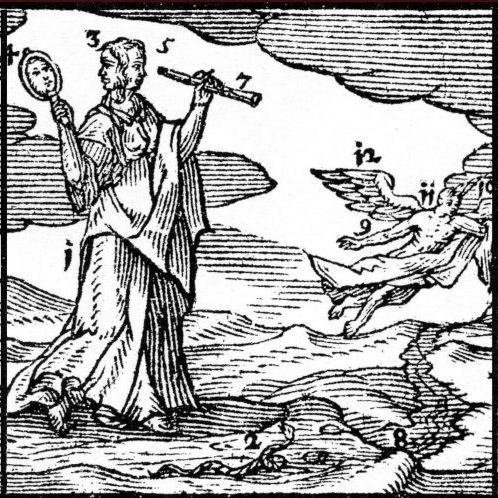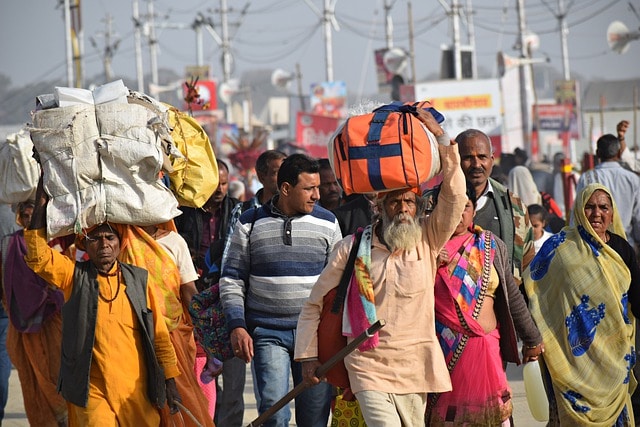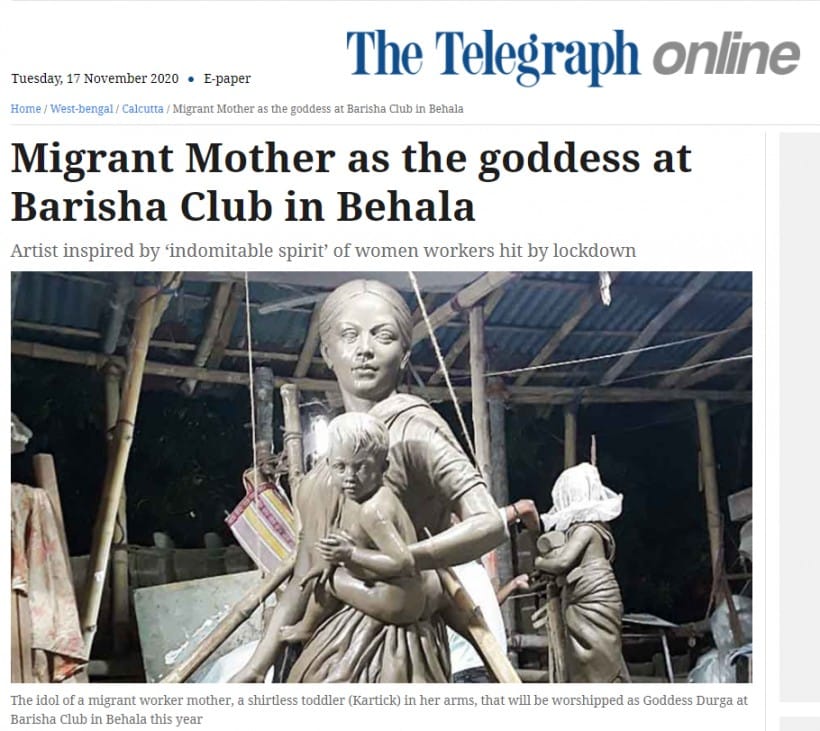For the occasion of this year’s Durga Puja festival in Kolkata, the likeness of a migrant woman was chosen for a much-celebrated idol of the Hindu goddess Durga. Dressed in plain saree and with a toda (anklet) around her feet, she carried one of her children in her arms. The other two were beside her as the scene evoked the long journey she embarked on in search of food and shelter.
The figure symbolized the hunger and poverty of migrant workers in India that had received global attention due to the pandemic-driven lockdown, which was declared by the Indian government on March 24, 2020 – with only a 4-hour notice. The figure was also a celebration of the goddess as the woman “who braved the scorching sun and hunger and penury along with her children,” explained the artist. Hunger was the ‘Demon’ that she fought in this year’s portrayal.
A similar scene played out on Indian television. After the suspension of public transport services due to the curfew-style lockdown, over 10 million migrant workers were forced to travel — mostly on foot — hundreds of kilometers to reach their places of origin. “I want to see my wife and kids,” a construction worker from Bihar who was working in the tech city of Bangalore told a journalist. A news channel reported this as a matter of national pride: “Look how strong and brave the migrant workers from our villages are,” the anchor exclaimed during an episode of a news hour I happened to watch during those days. When Jyoti Kumari Paswan, a young 15-year-old girl, cycled 1,200 km with her ailing father in the back seat to their home village, the Indian press was ablaze with news about the “’Lionhearted’ Girl [who] Bike[d] Dad across India, Inspiring a Nation.”
These scenes framed economic hardships of migrant workers in India as signs of their individualised feats of strength more so than the misery and destitution, which is embedded in institutional violence; bringing their sufferings to light through art, media and politics. The assumption being that they have been unrecognized so far. What occasioned such romantic translations?
Their invisible labour is eked out to extend infrastructural modernity in big cities.
In her 2018 book Nightmarch, Alpa Shah, a scholar of political and economic anthropology studying inequality and poverty in the tribal belts of India, describes how numerous people migrate from the tribal regions of India to work at construction sites in the underbellies of metropolitan spaces like Kolkata. Their jobs entail long periods of stay away from home, dependence on exploitative contractors, with only meagre earnings and savings from precarious livelihoods. Their invisible labour is eked out to extend infrastructural modernity in big cities.
Yet it’s not like they are completely invisible from urban spaces. Sometimes they ‘dare’ enter the private realm of educated urban middle and upper classes in Kolkata, where they are indeed spoken about in our personal conversations: “My Uber driver from so-and-so place spoke in a weird accent; he didn’t understand a word of what I was saying”, and “my maid wanted a holiday for Diwali and Durga puja, she expected my house to remain unclean — [impure?] — during the festival season!” By identifying migrant labourers as people who speak something akin to a different language, and who do not understand urban ‘culture’, we perform our biases against migrant workers in everyday interactions, and that is also how we unrecognise and ‘other’ them.
Meanwhile, on social media, and in the commentary section of digital media, some were upset about this profane choice of likeness for Durga, considering it “de-Hinduised” and generally inappropriate. But others were in turn dismayed by such a failure to appreciate the local culture of Bengal of celebrating festivals of goddesses. Why were people unable (or unwilling?) to appreciate artistic expressions? “Those outraging over the idol’s depiction must educate themselves about [West] Bengal’s culture of celebrating Durga Puja,” read an article. What does this reference to ‘culture’ signify?
Wild legitimacy lies in the term, culture. Conversations reach an impasse under its claim.
Wild legitimacy lies in the term, culture. Conversations reach an impasse under its claim. As though there’s one self-explanatory meaning of the word that naturally commands respect, evades further scrutiny, and is so rich and deep that others have to be ‘educated’ into it. I believe this understanding about culture becomes particularly relevant in the context of caste Hindus in cities such as Kolkata wherein the upper castes benefit from an on-going colonial and postcolonial legacy of knowledge and power production to mark their putatively innate cultural superiority, while suppressing questions about their entitlements.
When people insist that their culture is special and are tone-deaf to any criticism against it, they feed into a form of ideology that selectively excludes some of the realities of its political and economic practices. The arrogance that allows someone to be romantic about the image of a migrant woman as a goddess in the name of performing our culture, I imagine, emerges from this unproblematic and depoliticized definition of culture.
So what to make of this framing of migrant women through a festival which draws huge capital for the celebration? In recent years, it has attracted many influential artists, and corporate brands, with a lot of money at stake. It is a festival that soaks in the consumerist extravagance of food and apparel — flexible capitalism — and indulges in unimaginable wastage of electricity. An expression rather than an indictment of an alienating, exploiting, and dehumanizing system, it transports the notion that the relentless pursuit of profits can be counterbalanced with benevolent art.
It is also in the non-consumptive, leisurely dimensions of culture that unequal division of labour and oppressive modes of productions reaffirm their presence.
Even the attempt to think critically about culture, then, is limited to a moral ideology. Some people lament the loss of traditional celebration of Durga puja and its fading appeal among the youth. Modern theme-based celebrations made popular since the 2000s, as well as club-sponsored pujo in paras (localities) of Kolkata, are sometimes criticized for being only geared towards money, competition, awards and advertisements. These distinctions between traditional and modern, religious and non-religious, and ritual and commercial aspects of ‘culture’ presume that capitalism is generated only when consumption is excessive, seldom realizing, as anthropologist Sam Dubal (borrowing from Karl Marx) argues in the context of ‘play’, that it is also in the non-consumptive, leisurely dimensions of culture that unequal division of labour and oppressive modes of productions reaffirm their presence.
The romanticization of poverty
Moreover, I read this visual imagery of putting underprivileged women on a pedestal, and its celebration especially by the middle-upper-class elites, as an extension of the institutionally internalized savior syndrome directed towards poor brown women, which feminist anthropologists of postcolonial studies warned us about. The artist did not add colour to the idol because he “did not want her to look like a doll,” he wanted to keep his Durga “as real as possible”, and through this soft image-making, and through what anthropologist Liisa Malkki calls the spectacle of “raw,” “bare” humanity, he evoked the notion of a simple rural woman to be worshipped. This form of humanity is possible by the depiction of women and children as helpless, writes Malkki in her 1996 essay on speechless emissaries, anything else would defeat the purpose of a universal apolitical empathy towards humanitarian crisis.
In such a depiction of humanitarianism, there is always an element of creating knowledge about the oppression of women in ‘other’ communities. It rings hollow, and diminishes material struggles of marginalized communities. Missing in the discussions about the plight of migrant women is a critical recognition that evoking pity, sympathy, benevolence and awareness about migrant women or treating them as goddesses does not automatically solve the problem of poverty and hunger, but it certainly undermines critical politicization of power relations.
It is important to ask if this recognition is any different from banging utensils for and showering flower petals on frontline health workers during the pandemic to appreciate their work? True, numerous Indians participated in this campaign by the central government. But many others were also critical of the gesture at a time when these workers urgently needed better protective equipment to safeguard themselves from the Coronavirus infection.
When news platforms say, “migrant workers brave heat, battle hunger as they walk to their hometowns,” or “migrants brave sun, walk on highway to reach home”, what are they implying then? Are poverty and hunger naturally occurring situations that migrants ‘fight’? Where lies the blame; what led to the ‘crisis’; who must be held accountable for it?
Are poverty and hunger naturally occurring situations that migrants ‘fight’? Where lies the blame; what led to the ‘crisis’; who must be held accountable for it?
How do we then speak about poverty and migrant women without expressing ourselves in the language of those who we do not agree with? Certainly not by using hunger and poverty as abstract ‘Demons’ but acknowledging them as human-made structural inequalities.
India ranked 94 among 107 countries in the Global Hunger Index 2020. The pandemic-related large-scale migration in search of shelter and food is not overnight responsible for this score. After the complete clampdown on the economy, it became evident that there are millions of lives which painstakingly live from hand to mouth. They rely on their daily wages. Losing even a day’s income can be devastating under these circumstances, wherein there is no savings to fall back. And here they were left without earnings or work for 3 long months due to the elite expectation that everyone should stay at home and maintain distance during the pandemic, without any health care or financial benefits from the government.
Treating hunger as the ‘Demon’ is a political dead end.
Therefore, treating hunger as the ‘Demon’, as though it is an objective parameter devoid of ideological standpoint of the current political realm is a political dead end. It ignores the most crucial argument against inequality that it is through the making of categorical distinctions between the impoverished conditions and the agency of the actors who created it that poverty generates as a vicious cycle.
Next time Goddess Durga can be the man who broke down in the middle of the road on hearing about his son’s death. The onlooking police and media can be the reckless children who are too self-involved to care. The politicians who shut down the state borders to prevent migrant workers from entering can be the roadblocking demons. The power of the goddess will not be about braving the strenuous journey to fight hunger — for which she hardly has a choice — but in pausing to shed tears and grieve about her sorrows, her losses. The idol of this goddess should make us angry for the system that we are.










